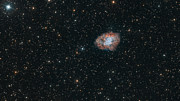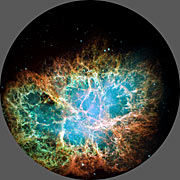Moving heart of the Crab Nebula
Digitized Sky Survey 2 image of the Crab Nebula (ground-based image)
Videos

Zooming in on the Crab Nebula
The Crab Nebula as never seen before
This new NASA/ESA Hubble Space Telescope
image reveals the beating heart of one of the most visually appealing,
and most studied, supernova remnants known — the Crab Nebula. At the
centre of this nebula the spinning core of a deceased star breathes life
into the gas that surrounds it.
The Crab Nebula, which lies 6500 light-years away in the constellation of Taurus (The Bull), is the result of a supernova — a colossal explosion that was the dying act of a massive star.
During this explosion most of the material that made up the star was
blown into space at immense speeds, forming an expanding cloud of gas
known as a supernova remnant.
This extraordinary view of the nebula is one that has never been seen before. Unlike many popular images
of this well-known object, which highlight the spectacular filaments in
the outer regions, this image shows just the inner part of the nebula
and combines three separate high-resolution images — each represented in a different colour — taken around ten years apart.
At the very centre of the Crab Nebula lies what remains of the
innermost core of the original star, now a strange and exotic object
known as a neutron star. Made entirely of subatomic particles called neutrons,
a neutron star has about the same mass as the Sun, but compressed into a
sphere only a few tens of kilometres across. A typical neutron star
spins incredibly fast and the one at the centre of the Crab Nebula is no
exception, rotating approximately 30 times per second.
The region around a neutron star is a showcase for extreme physical
processes and considerable violence. The rapid motion of the material
nearest to the star is revealed by the subtle rainbow of colours in this
time-lapse image, the rainbow effect being due to the movement of
material over the time between one image and another.
Hubble’s sharp eye also captures the intricate details of the ionised gas,
shown in red in this image, that forms a swirling medley of cavities
and filaments. Inside this shell of ionised gas a ghostly blue glow
surrounds the spinning neutron star. This glow is radiation given off by
electrons spiralling in the powerful magnetic field around the star at nearly the speed of light [1].
The supernova explosion from which the Crab Nebula was born was one of the first to be recorded in human history [2].
This has made the Crab Nebula an invaluable object for the study of
supernova remnants and has enabled astronomers to probe the lives and
deaths of stars as never before.
Notes
[1] The star’s intense magnetic field is channelling infalling gas
and dust to the star’s poles where it is ejected at immense speeds. Two
symmetric jets of material are beamed out from the poles, sweeping out
into space as the star rotates. Rather like a lighthouse beam, the jets
periodically point towards Earth and present astronomers with a blinking
— or pulsing — source of light in the sky. Accordingly, these objects
are known as pulsars.
[2] The story began in the year 1054
CE, when a new star became visible in the night sky. The new star was
the brightest object in the night sky, second only to the Moon. At the
time, Chinese and Japanese astronomers recorded the event, and monitored
the new star as it gradually faded in brightness until, after several
years, it became invisible to the naked eye.
More Information
The Hubble Space Telescope is a project of international cooperation between ESA and NASA.
Image credit: NASA, ESA
Links
- Images of Hubble
- Peering into the heart of the Crab Nebula
- Crab Nebula in different Wavelengths
- Link to hubblesite release
Contacts
Mathias Jäger
ESA/Hubble Public Information Officer
Garching bei München, Germany
Cell: +49 176 62397500
Email: mjaeger@partner.eso.org
Mathias Jäger
ESA/Hubble Public Information Officer
Garching bei München, Germany
Cell: +49 176 62397500
Email: mjaeger@partner.eso.org
Source: ESA/Hubble/News


